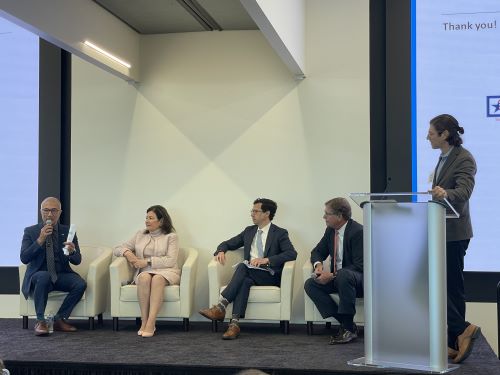Immigration Benefits All Americans and Strengthens the Economy
The following article was originally published on FWD.US and reprinted with permission:
 The facts are clear: immigrants and immigration are good for America and all Americans.
The facts are clear: immigrants and immigration are good for America and all Americans.
Immigration strengthens the U.S. economy and contributes to greater prosperity for all Americans. Immigrants help create jobs, raise wages, reduce inflation, and increase productivity and innovation. Immigrants boost virtually every sector of the economy, and they play particularly important roles in critical sectors like healthcare, food production and agriculture, construction, and emerging fields like semiconductors and artificial intelligence.
This brief provides an overview of research, including FWD.us’ original analysis, documenting just some of the numerous ways in which immigration benefits the United States.
“Immigration will contribute to a $7 trillion increase in GDP and $1 trillion in additional government revenue over the next decade.”
A bigger economy, more government revenue, and greater prosperity
Immigration helps grow and strengthen the U.S. economy. In the simplest terms, more people spending money on goods and services increases the U.S.’ gross domestic product (GDP), one of the most important measures of our economy’s health. In turn, the increased demand for goods and services can spur the creation of new businesses and more jobs. One study found that immigrants account for 17% of U.S. GDP, amounting to $3.3 trillion.
Because a large share of immigrants are of working age, and are very productive and entrepreneurial, increasing immigration also increases per capita GDP, or each person’s share of economic output. Higher GDP per capita means a higher standard of living for Americans and a greater share, on average, of the country’s prosperity.
Immigrants pay nearly $525 billion annually in federal, state, and local taxes, a vital contribution to revenue. This number includes contributions from refugees and people seeking asylum, whose economic contributions significantly outweigh any support they receive from the government, and undocumented immigrants, who pay nearly $50 billion in taxes annually, despite being ineligible to access most federal or state-funded benefits. Their payments sustain crucial public benefits like Social Security and support public services like schools and roads.
The director of the Congressional Budget Office (CBO) reported in February that recent immigration has shrunk the federal deficit and will contribute to a $7 trillion increase in GDP and $1 trillion in additional government revenue over the next decade.
By contrast, restricting immigration would shrink the economy, cost jobs, reduce the goods and services available to consumers, and cede the U.S.’ global economic leadership, leaving America smaller, poorer, and weaker.
“More than 18% of healthcare workers and 20% of STEM workers are immigrants.”
Filling workforce gaps and reducing inflation
Simply put, the U.S. cannot grow its workforce without increasing immigration. Immigrants made up 18.1% of the overall labor force in 2022, a sizable share that has increased in recent years and continues to increase. Because immigrants are more likely to be working age, they help fill gaps in the workforce, particularly in certain critical industries.
More than 18% of healthcare workers were born outside of the United States, including 26% of physicians, 16% of registered nurses, and 40% of home healthcare workers. They help reduce the harmful impacts of persistent workforce shortages that have challenged the healthcare sector for many years, and were exacerbated by the COVID-19 pandemic.
As the U.S. economy has grappled with labor shortages in the aftermath of the pandemic, newly arrived immigrants, particularly those admitted through humanitarian parole, have helped fill open jobs and restore supply chains, averting a major economic crisis.
Nearly 20% of workers in science, technology, engineering, and mathematics (STEM) fields, including critical and emerging technology sectors like semiconductors and artificial intelligence, are immigrants. And international student graduates receive roughly 40% of advanced STEM degrees at U.S. colleges and universities.
FWD.us analysis shows that immigration also reduces inflation by helping to close the labor gaps that drive consumer price increases that outpace wage gains—lowering costs for all Americans. Increased immigration in recent years helped reverse inflationary pressures and maintain stable economic growth.
"Immigration contributes to increased employment, higher productivity and higher wages for U.S.-born workers."
Creating jobs and boosting innovation and productivity
Immigrants are highly entrepreneurial, launching new businesses at twice the rate of U.S.-born individuals. About 45% of Fortune 500 companies in 2023 were founded by immigrants or their children, while immigrants founded 55% of U.S. startups valued at $1 billion or more.
Immigrant workers do not displace U.S.-born workers, and, in many cases, immigrants are associated with increased employment for native-born workers. Immigration has little to no effect on wages for U.S.-born workers, and in fact contribute to higher productivity and wages, especially in fields requiring advanced skills. On the other hand, restricting immigration does not improve employment opportunities for U.S.-born workers, and contributes to the offshoring of jobs and business creation to other countries.
Immigrants contribute significantly to innovation in the U.S. Recent research shows that immigrants account for nearly a quarter of total innovation output, despite making up only 16% of U.S. inventors. These high levels of innovation and productivity drive technological advancements in the U.S., but also drive global technological advancement.
Many entrepreneurs and innovators originally came to the U.S. as international students, and these individuals also contribute significantly to our economy. In the 2022-2023 school year alone, international students contributed $40.1 billion to the U.S. economy and supported more than 368,000 jobs.
“Immigrants help counter population decline because they increase the size of the working age population and build families in the U.S., contributing to future population growth.”
Reversing demographic decline, particularly in rural communities
Between 2010 and 2020, the U.S. saw its slowest population growth of any decade since the 1930s, and, in recent years, fewer children have been born. Declines in annual immigration levels have contributed to these declines. The United States, like many countries, also faces the challenges of an aging population, which leaves fewer working-age individuals in the workforce, while a growing senior population presents additional challenges.
Immigrants help counter these trends because they increase the size of the working-age population and build families in the U.S., contributing to future population growth. They are also strongly represented in industries that support aging adults, like healthcare.
The U.S. will need to increase immigration levels to ensure that we can continue to sustain our communities and continue growing the economy. FWD.us analysis shows that raising immigration levels by 50% annually would increase the projected U.S. working-age population by about 13% by 2040, which would provide for current and growing labor needs, while also further expanding the U.S. economy.
This dynamic is particularly important in rural American counties, which have been hit hard by population declines. FWD.us research finds that more than three-quarters (77%) of U.S. rural counties have fewer working-age people today than 20 years ago. These losses can cripple local economies and make it difficult for residents to access healthcare and other critical services.
Adding just 200 new immigrants each year would reverse declines for nearly three-quarters (71%) of these counties by 2040.
Looking forward
Decades of data clearly show that immigrants and immigration are good for America and Americans. It is vital that U.S. policymakers should work to preserve and enhance the benefits of immigration by building new legal avenues and increasing opportunities for newcomers to support themselves, participate in their local communities, and contribute to the United States’ success and prosperity.








